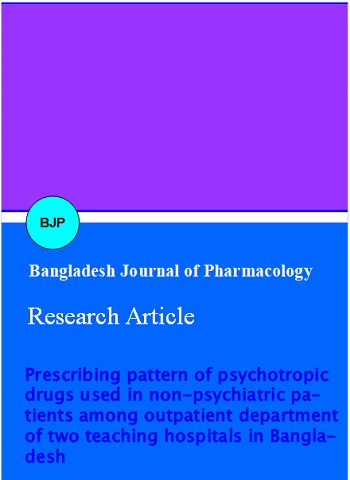Prescribing pattern of psychotropic drugs used in non-psychiatric patients among outpatient department of two teaching hospitals in Bangladesh
DOI:
https://doi.org/10.3329/bjp.v10i1.21463Keywords:
Prescribing pattern, Psychotropic drug, Non-psychiatricAbstract
The objectives were to evaluate the prevalence, pattern and rational of psychotropic drugs prescribing by general physicians in two teaching hospitals in Bangladesh in non-psychiatric patient. 320 patients from Sir Salimullah Medical College Hospitals and 240 patients from Holy Family Red Crescent Medical College Hospitals who visited other than psychiatry ward, received psychotropic drugs between July 2012 to June 2013 were analyzed. The rate of psychotropic drugs prescribing was 8.3% and 11.2% in SSMC and HFRCMCH respectively which was found to increase with increasing age and female patient. Benzodiazepines were the most commonly prescribed drugs followed by antidepressant and psychotropic drugs. The psychotropic drugs use was found more in different physical disorder.
Downloads
371
246 Read
218

Additional Files
Published
How to Cite
Issue
Section
License
Authors who publish with this journal agree to the following terms:
- Authors retain copyright and grant the journal right of first publication with the work simultaneously licensed under a Creative Commons Attribution License that allows others to share the work with an acknowledgement of the work's authorship and initial publication in this journal.
- Authors are able to enter into separate, additional contractual arrangements for the non-exclusive distribution of the journal's published version of the work (e.g., post it to an institutional repository or publish it in a book), with an acknowledgement of its initial publication in this journal.
- Authors are permitted and encouraged to post their work online (e.g., in institutional repositories or on their website) prior to and during the submission process, as it can lead to productive exchanges, as well as earlier and greater citation of published work (See The Effect of Open Access).
